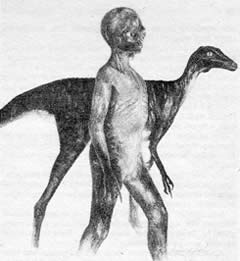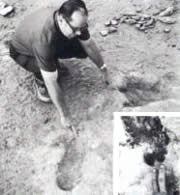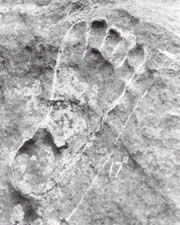by Brad Steiger
 | ||
|
The notion that early humans might have been contemporaneous with the giant reptiles has stoked the creative fires of many a fantasy and science fiction novelist. In Worlds Before Our Own (Anomalist Books, 2007), I pose a two-pronged question: Did a race of early humans exist during the Age of Reptiles, something like 70 million years ago; or did a certain number of the giant reptiles survive until a few thousand years ago?
Early in January, 1970, the London Express Service carried an item relating the discovery of a set of cave paintings which had been found in the Gorozamzi Hills, twenty-five miles from Salisbury in Rhodesia. According to the news story, the paintings included an accurate representation of a brontosaurus, the 67-foot, 30-ton behemoth that scientists insist became extinct millions of years before man achieved his earthly advent.
Experts agree that the paintings were done by bushmen who ruled Rhodesia from about 1500 B.C.E. until a few hundred years ago. The experts also agree that the bushmen only painted from life. This belief is borne out by the other Gorozamzi Hills cave paintings, which represent elephants, hippos, deer, and giraffe.
The November, 1968, issue of Science Digest carried the startling thoughts of Mexican archaeologist-journalist Jose Diaz-Bolio concerning his discovery of an ancient Mayan relief sculpture of a peculiar serpent-bird found in the ruins of Tajin, located in Totonacapan in the northeastern section of Veracruz, Mexico. Diaz- Bolio suggested that the serpent-bird was not merely the product of Mayan flights of fancy, but a realistic representation of an animal that lived during the period of the ancient Mayans — 1,000 to 5,000 years ago.
A startling evolutionary oddity would have been manifested if such serpent-birds were contemporary with the ancient Mayan culture, for creatures with such characteristics are believed to have disappeared 130 million years ago. The archaeornis and archaeopteryx, to which the sculpture bears a resemblance, were flying reptiles that became extinct during the Mesozoic age.
William Meister, an amateur rockhound, found what appears to be a fossilized human sandal print with a trilobite, an extinct marine animal, imbedded in the impression made by the heel. Meister discovered the print in July, 1968, while searching for fossils at Antelope Springs, near Delta, Utah. Since the impression was made on what once may have been a sandy beach of the Cambrian period of the Paelozoic Era, the sandal print would have to be an incredible 500 million years old.
 | ||
|
Dr. Clifford Burdick personally investigated William Meister’s find, and while digging in the same area where the rockhound had found the remarkable sandal print, he himself found a human track similar to the first one Meister discovered, evidently made by shoes or moccasins. Professors of the geological department of a leading university conceded that the tracks definitely looked human, but they could not accept their biological origins.
Dr. Burdick commented that the manlike tracks found at Antelope Springs, preserved in rock hundreds of feet below the present surface of the ground, may have been covered at or near the beginning of some great catastrophic, earth-shaking event that buried many forms of life all together, some marine and some non-marine.
“If these are verified as human tracks,” he said, “the discovery will have far-reaching repercussions throughout the scientific world, and especially for stratigraphers and palaeontologists. Cambrian fossils such as trilobites, are placed at the bottom of the Palaeozoic, some estimated 600 million years before man evolved, according to evolutionary geology. This evidence, if verified, will practically collapse the geologic column.”
In addition to the giant footprints of manlike bipedal creatures discovered throughout the southwestern United States, other indications that a much larger race inhabited North America in prehistoric times came with the discovery in Supai Canyon, Arizona, of a petroglyph depicting a mammoth attacking a man. This primitive work of art was found by Harold T. Wilkins, who determined that the beleaguered man must have been over ten feet tall, according to the perspective employed by the ancient artist. Amerindians in the vicinity stated that the drawings had been made by the “giants of long ago.”
The New York Times on December 2, 1930, carried an item that told of the discovery of the remains of an apparent race of giants who once lived at Sayopa, Sonora, a mining town 300 miles south of the Mexican border. A mining engineer, J. E. Coker, said that labourers clearing ranchland near the Yazui River “dug into an old cemetery where bodies of men, averaging eight feet in height, were found buried tier by tier. . . .”
On February 14, 1936″ The New York Times ran a piece datelined Managua, Nicaragua, which stated that the skeleton of a gigantic man, with the head missing, had been unearthed at El Boquin, on the Mico River, in the Chontales district. “The ribs are a yard long and four inches wide and the shin bone is too heavy for one man to carry. ‘Chontales’ is an Indian word, meaning ‘wild man.’
In its June 9, 1936 issue, The New York Times published an article item with a Miami, Florida dateline that told of human skeletons eight feet long imbedded in the sand of an uninhabited little island off Southern Florida. E. M. Miller, zoologist at the University of Miami, commented that the skulls were unusually thick, the jaws protruded, and the eye sockets were high in the head.
In his book emtitled Forbidden Land, Robert R. Lyman wrote of an unknown tribe of American giants who had the added distinction of having horns growing from their heads:
“At Tioga Point … a short distance from Sayre, in Bradford County (Pennsylvania]… they uncovered an Indian mound [and] found the bones of 68 men which were believed to have been buried about the year 1200. The average height of these men was seven feet, while many were much taller. On some of the skulls, two inches above the perfectly formed forehead, were protuberances of bone, evidently horns that had been there since birth. Some of the specimens were sent to the American Investigating Museum.
“. . . In December 1886, W. H. Scoville of Andrews Settlement discovered an Indian mound at Ellisburg. When opened, the skeleton of a man was found. It was close to eight feet in length.”
According to their oral tradition, the Delaware tribe once lived in the western United States. At some point in their history, they migrated eastward as far as the Mississippi River, where they were joined by the Iroquois Confederacy. Both groups of people were seeking land better suited to their rather cultured way of life, and they continued together on their eastward trek.
Scouts sent ahead learned of a nation that inhabited the land east of the Mississippi and who had built strong, walled cities. These people were known as the Talligewi or Allegewi, after whom the Allegheny River and Mountains are named. The Allegewi were considered taller than either the Iroquois or the Delaware, and the scouts saw a good many giants walking among them.
When the two migrating tribes asked permission to pass through the land of the Allegewi, it was denied. Bitter fighting broke out, which continued for a number of years. EventualIy, the superior numbers and the determination of the allies prevailed, and the Allegewi fled to the west.
The Allegewi next appear in the legends of the Sioux, whose tradition tells of a confrontation with a race of great stature. The Sioux, who were surely among the ablest of warriors, exterminated the Allegewi when the giants sought to settle in what is now Minnesota.
Is there any archaeological evidence to support these tribal legends and traditions?
Rising out of the earth in Ohio, Minnesota, Iowa, and other states are the huge Earthworks of the mysterious “moundbuilders.” The mounds scattered throughout the Midwest were apparently raised by the same unknown people, and the earthworks are extremely large.
Do giant mounds indicate giant people?
Enormous weapons, including a copper ax weighing 38 pounds, have been found in these mounds. It is difficult to imagine the average-sized Amerindian, as we first know him at the time of the European invasion, casually wielding a 38-pound axe.
However, outsized weapons and implements alone are not proof of a giant race, and neither are huge monuments. The former can be works of art, the latter could be objects of religious commitment. The best proof of a race of giants in North America– or anywhere else — would be the discovery of the skeletons of these people.
Two brothers living in Dresbach, Minnesota, in the process of enlarging their brick business, were forced to remove a number of large Indian mounds. In one of the huge earthenworks they discovered the bones of “men over eight feet tall.”
In La Crescent, Minnesota, not far from Dresbach, mound-diggers reportedly found large skillets and “bones of men of huge stature.”
Over in Chatfield, mounds were excavated, revealing six skeletons of enormous size.
Unusually large skeletons of seven people buried head down were discovered in Clearwater. The skulls in the latter find were said to have had receding foreheads, and teeth that were double all the way around.
Other discoveries in Minnesota included “men of more than ordinary size” in Moose Island Lake; several skeletons, one of “gigantic size” in Pine City; ten skeletons “of both sexes and of gigantic size” in Warren (buried with these particular specimens were horses, badgers, and dogs).
Could these huge skeletons of gigantic “indians” be all that remains of the last of a proud prehistoric race who defied the monster reptiles and built an extensive empire of walled cities throughout the Americas?
Dr. Clifford Burdick first began investigating “footprints in stone” in the early 1950s when the Natural Science Foundation of Los Angeles assigned him to go with four other members to examine the reported man-tracks found in strata contemporaneous with dinosaur prints in and around Glen Rose, Texas. The committee soon learned that men had been cutting dinosaur and human tracks out of the limestone of the Paluxy River bed near Glen Rose since at least 1938. A Mr. A. Berry gave them an affidavit which stated that in September of that year, he and other men found “many dinosaur tracks, several sabre-tooth tiger tracks, and three human tracks” in the river bed.
Dr. Burdick learned that Dr. Roland Bird, field explorer for the American Museum of Natural History of New York City, had also examined the Berry tracks. Describing them in the May 1939 edition of Natural Historymagazine, Bird admitted that he had never seen anything like the tracks, and assessed them as “perfect in every detail.” But since the man-like tracks measured 16 inches from toe to heel, Bird declared that they were too large to be human, although the barefoot tracks did show all the toes, insteps, and heels in the proper proportions. When Dr. Bird made a special field trip to the Paluxy River to examine the tracks in situ, he became less enthusiastic about the prints in association with dinosaur tracks, because “man did not live in the age of dinosaurs.”
Whatever species of creature made these tracks, it was definitely bipedal. The footprints all have about the same length of stride, which would be consistent with a man with a 16-inch foot. The shapes of the prints are more manlike than any other animal known to science.
If the tracks are accepted as being human, then scientists will be forced either to place man back in time to the Cretaceous period or to bring the dinosaur forward to the Pleistocene or Recent period.
In referring to the evidence of the Glen Rose tracks, Dr. Burdick states that the generally accepted theory of evolution would be dealt a lethal blow, because the geologic record of human footprints contemporaneous with dinosaur tracks “suggests that simple and complex types of life were coexistent in time past or during geologic ages. . . . This does not harmonize with the hypothesis that complex types of life evolved from lower or more simple forms. Evolution implies that through the geologic ages life has not only become more complex, but has increased in size. If evidence from the man-tracks can be used as a criterion, ancient man was much larger than modern man as an average. This harmonized with most fossil life which was larger than its modern counterpart. . . . On the whole, biological life has had to contend with unfavorable environment which has been a factor in its degeneration, rather than its evolution.”
 | ||
|
For years, Frank X. Tolbert wrote about the alleged mantracks in the Paluxy River in his “Tolbert’s Texas” column in the Dallas Morning News. Consistently skeptical that the prints were made by humans, Tolbert maintained that the tracks had been made by giant sloths. But in his January 6, 1973 column, Tolbert reported “what may be the clearest of the so-called ‘giant men tracks’ yet discovered”– a footprint of “a huge humanoid” measuring 21 1/2 inches in length, 8 inches in width across the front of the foot, and 5 1/2 inches across the instep.
Dr. C. N. Dougherty of Glen Rose stated that near the footprint are also the deeply engraved prints of three-toed dinosaurs. “These men-tracks belong to the Mesozoic Era because the clearest man-track is exactly eight inches from a trachodon track and on the same layer of rock,” said Dr. Dougherty. “The trachodon tracks are as clear and distinct as the man-track. ”
According to Dr. Dougherty: “When I discovered this trail of a giant man under the waterfall, I had a feeling that it was one of the most important discoveries since the Dead Sea Scrolls.”
The thing that most intrigued Tolbert is that the prints are each 21 1/2 inches in length, “And they indicate that these men who were contemporaries of the brontosaurus, if men they were, walked with a stride of seven feet.”
Some might conjecture that such giant humans might have been able to band together and put up a pretty good fight against any giant reptile.
Make a Member Pledge of $100.00 to The Canadian Exopolitics Newspaper, and get our DVD on UFOs and Extraterrestrials as a gift, sent to you in the mail. Help support our socially progressive, volunteer-driven, and not-for-profit national newspaper. LINK of The Canadian, with your donation-pledge. Help support independent, progressive, and not-for-profit newspaper.
Mega colaboração: Elaine Maria Hadad
Nenhum comentário:
Postar um comentário